Lately I’ve been having a lot of conversations around investment terms with searchers, as well as investors.
About 15 years ago, I interned at a search fund. And, over the last few years, I’ve started to invest in the asset class going direct as well as through funds of search funds.
Investing in search funds is a great way to scratch my entrepreneurial itch, extremely rewarding when a searcher finds success, and can be economically rewarding too.
This post is my attempt to share thoughts on self funded search economics in an effort to contribute to the search fund community, get feedback on my thinking from a wider audience, and of course meet more people who are doing searches/investing and may want to collaborate (please feel free to reach out!).
You can watch a video of me explaining this model here, and download the excel here:

Enterprise Value
The standard finance equation is enterprise value = debt + stock – cash. Enterprise value is how much the company itself is worth. Many times people confuse it with how much the stock is worth and find the “minus cash” part of this really confusing.
So, you can rearrange this equation to make it stock = enterprise value – debt + cash. Make more sense now?
Enterprise value is just how much you’re willing to pay for the company (future cash flows, intellectual property, etc), not the balance sheet (debt and cash).
Most investors and searchers think about the EBITDA multiple of a company on an enterprise value basis because they’ll be buying it on a cash free, debt free basis. It becomes second nature to think about EBITDA multiples and know where a given business should fall given scale, industry, etc.
However, I believe this second nature way of thinking of things can be a massive disadvantage to investors given the way EV and multiples are talked about in our community currently.
Sources of capital, the typical way to calculate enterprise value for self funded searchers
If you’ve ever looked at or put together a teaser for a self funded search deal, you will notice that the deal value is equal to the sum of the sources of capital minus deal fees and cash to the balance sheet.
As a simple example, if there is $4 mm of debt to fund the deal, $1 mm of equity, and $200k of deal fees, the enterprise value = $4 mm + $1 mm – 200k = $4.8 mm.
We’ll use slightly more complex numbers in our example: If a searcher is taking a $3.2 mm SBA loan, $850k seller note, putting in $120k themselves, getting $350k of equity from the seller, a $500k earnout, and $1.2 mm of equity financing minus $350k to the balance sheet and $250k of deal fees, then the enterprise value will be $5.62 mm.
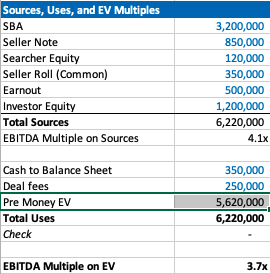
Our example company has $1.5 mm of EBITDA, so the EBITDA multiple is 3.7x. This is a pretty attractive acquisition multiple for a business that meets traditional search criteria (recurring revenues, fragmented competition, high gross margins, low customer concentration, etc).
If you’re seeing a search fund deal for the first time, the headline of “we’re buying a decent company for 3.7x, and replacing a tired owner with a hungry operator” is pretty exciting!
However, if you’re an investor, there is some nuance to this enterprise value number and the true EBITDA multiple you are investing in.
The trick with self funded enterprise value
The security that most self funded search investors get in a deal is participating preferred stock with a paid in kind dividend. This means when there’s an exit, you get your money back before any other equity holder, then get a certain percent of the business, and whatever dividend you’ve been owed in the interim accrues to your principle.
It’s a really favorable security for the investor, and one that is basically impossible to get in VC where straight preferred stock is much more common (no pun intended).
The key terms are what percent of common equity does this security convert into after the originally principal is paid back, and what is the dividend.
The share of common equity the investor group will get typically ranges from 10-50% of the total common stock. The dividend rate is usually 3-15%. The average I’m seeing now is around 30% and 10% for common and dividends respectively.
The strange this about the enterprise value quoted to investors in a teaser/CIM is that it doesn’t change as the percent of common changes, even though this has large implications for how much the common equity is worth and the value investors receive.
For example, I may get a teaser where the sources of investment – cash to balance sheet – deal fees = $3.7 mm for a $1 mm EBITDA company, which would imply a 3.7X EBITDA multiple. Let’s say the searcher is offering investors 30% of the common and a 10% dividend.
Let’s now say that the searcher is having a tough time raising capital and changes their terms to 35% of common and a 12% dividend. Does the effective enterprise value change for investors? I would argue yes, but I would be surprised to see it changed in the CIM/teaser.
This isn’t a knock on searchers or the search fund community. It’s just kind of how things are done, and I think this is mostly because it’s really hard to think about how the enterprise value has changed in this scenario.
However, the natural way of using EBITDA multiples to think about value for a business that is so common in PE/SMB can be extremely misleading for investors here. You may be thinking 3.7X for this type of business is a great deal! But, what if the security you’re buying gets 5% of the common?
If you’re in our world, you may counter this point by saying most searchers will also supply a projected IRR for investors in their CIM. However, IRR is extremely sensitive to growth rate, margin expansion, and terminal value. While the attractiveness of the security will be reflected, it can be greatly overshadowed by lofty expectations.
To get more clarity and have a slightly different mental model on the effective price investors are paying for this business, let’s go back to basics. Enterprise value should be debt + preferred stock + common stock – cash.
We know the values of each of these numbers, except the common. So, the main question here becomes: how much is the common equity worth?
Calculating value of common equity for self funded search funds
Equity value for most search fund deals = preferred equity from investors + the common equity set aside for the searcher and sometimes also advisors, board, seller.
We know that the preferred equity is investing a certain amount for a certain amount of common equity. The rub is that they are also getting a preference that they can take out before any common equity gets proceeds, and they are getting a dividend.
So, the exercise of valuing the common equity comes down to valuing the preference and dividend.
In my mind, there are three approaches:
- The discount rate method where you take the cash flows you’ll get in the future from the pref/dividends and discount them back at the discount rate of your choice. I am using 30% in my model which I believe accurately compensates investors for the risks they are taking in a small, highly leveraged investment run by an unproven operator. If you believe in efficient markets, this number also fits as it mirrors the historical equity returns as reported by the Stanford report, with a slight discount given this asset class has clearly generated excess returns relative to other assets on a risk adjusted basis, hence interest in these opportunities from an expanding universe of investors.
- The second method is to calculate how much money you’d get from your preference and dividends, taking into account that per the Stanford study around 75% of search funds will be able to pay these sums, and then discount these cash flows back at a rate more in line with public equities (7% in my model). This yields a much higher value to the preference/dividend combo, and therefore lowers the implied value of the common equity.
- The last method is to just say nope, there is no value to the preference and dividend. I need them and require them as an investor, but they are a deal breaker for me if they aren’t there, and therefore they don’t exist in my math. This of course makes no logical sense (you need them, but they also have no value?), but I’ve left it in as I think many investors probably actually think this way and it creates a nice upper bound on the enterprise value. Side note, as with obstinate sellers, jerk investors are usually best avoided.
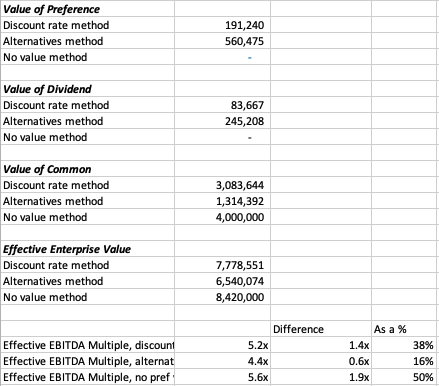
In our example, you can see a breakdown of the preference value, dividend value, and therefore common value and enterprise value for this deal.
In each case, the effective EBITDA multiple moves from 3.7x to something much higher (see the last 3 lines).
There are some simplifying assumptions in the model (no accruing dividend, all paid in last year), and some weird stuff that can happen (if you make the hold time long and the dividend greater than the 7% equity discount rate, the value of the dividend can get really big).
These flaws aside, I think this creates a nice framework to think through what the common is actually worth at close, and therefore what enterprise value investors will be paying in actuality.
It’s worth noting that the whole point of this is to benchmark the value you’re getting relative to market transactions in order to understand where you want to deploy your capital.
This creates a method to translate cash flow or EBITDA multiples of other opportunities on an apples to apples basis (if only there were a magical way to translate the risk associated with each as well!).
Another note, we could calculate the value of the common to be what this asset would trade at market today in a well run auction process minus any obligations (debt, preference, seller financing). However, I think that understates the option value inherent in this equity, a value that is only realized when a new manager takes over with more energy and know how.
There is a finance nerd rational for this. If you plot the value of equity in a leveraged company on a chart, it mirrors the payout of a call option. In both cases, the value of the security increases at a certain inflection point: when the value of equity rises above the strike price in an option, and when the enterprise value of a company rises above the debt level in a levered company.
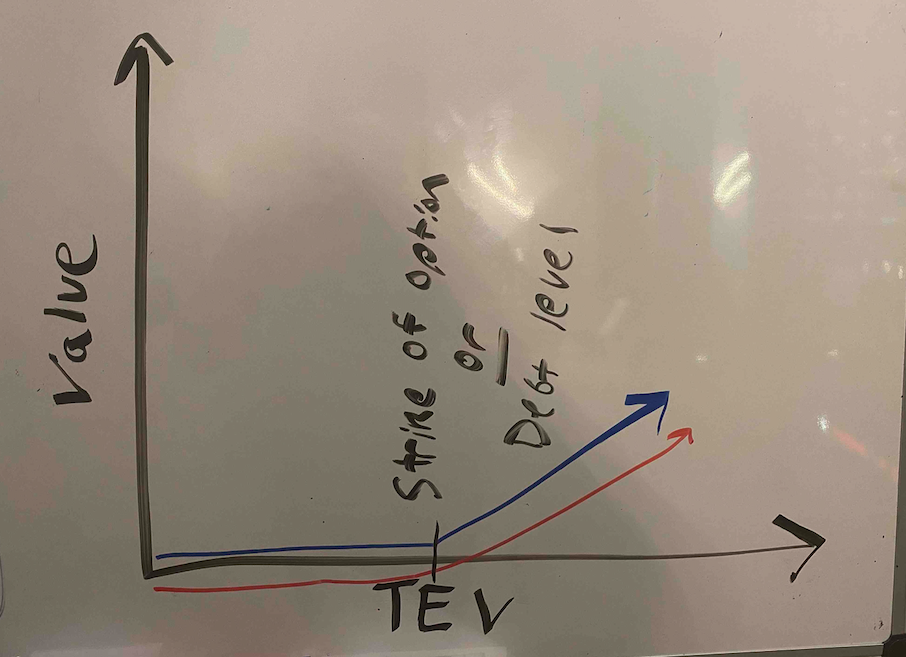
The common equity of a highly levered company can therefore be valued by a similar methodology as the call option: Black Scholes. If you remember back to finance class, increasing volatility will increase the value of an option.
In the search fund case, we’ve (hopefully) increased the (upside) volatility and therefore create more value than simply selling the company today.
A few more thoughts on investor economics
There are a few other ways to think about the economics you get as an investor to best understand if this is the deal for you.
First, you may want to think about how much your investment will be worth day 1. The key lever in this model is what discount this company is being bought for relative to fair market value. For example, the searcher may have proprietary sourced a great company and is buying it for 25% below what it would trade at in a brokered auction.
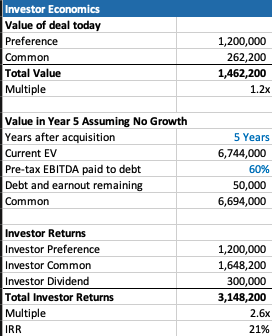
This is very much a “margin of safety” philosophy on things. Same with the calculation on how much you’ll receive in year 5 (after QSBS hits) assuming no growth in the business.
The only problem with each of these calculations is that they never play out in practice. Most companies don’t just stay the same, you’re either in a rising tide or you’re in trouble. And, you’re almost never going to sell in year 1, and definitely not for a slight premium to what it was bought for.
However, if your investment is worth 30% higher day one, and you can make a 20% IRR assuming nothing too crazy happens either way in the business, that’s not a bad place to start. Add in a strong searcher, decent market, some luck, and you’re off to the races.
Thoughts on searcher economics
A lot of this post has considered things from the investor perspective as my main quandary was related to how to create an EBITDA multiple that made sense for investors.
However, the point of this post is not to say searchers are misrepresenting or being unrealistic with their terms. In fact, I think it’s quite logical that self funded searchers capture the massive economic value that they do.
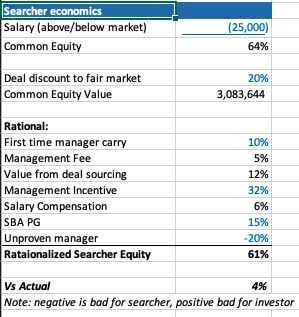
There are many reasons why self funded searchers deserve the lion share of the common equity.
First, they are providing a nice service of giving investors a positive expected value home to park their money with much lower correlation to the market than other asset classes ($1 mm EBITDA companies don’t see lots of multiple contraction/expansion throughout cycles).
Most money managers that fit that criteria are taking a 2/20, of course they also usually have a track record. So, I’ve used a 10% carry in my model, but stuck to 2% annual management fee.
The searcher spent a lot of time, and probably money, finding this company. That’s a lot of value, especially if it’s a below market price. They should be able to capture a lot of the value in finding a below market deal.
The searcher may be taking a below market salary, and needs to get comped like any CEO, with stock options. In my example model I have $1 mm of stock vesting over the hold period, as well as extra comp for taking a below market salary.
Searchers are also usually putting their financial standing at risk by taking a personal guarantee on the bank/SBA loan. This is really tough to put a number on, as is the last line in my framework where searchers are dinged for lack of experience. Like any good model, you need a few lines that you can fudge to make the math work 🙂
What you do think?
I’m shocked that I wrote all this. I was going to type a few paragraphs and a quick excel. However, putting this to paper has been a great exercise for me to sharpen my thinking.
Now I’d like you to help me further. Where do you think this should be changed in this framework? How do you think about things from the investor and/or searcher side?
Feel free to shoot me a note if you have thoughts (even just to tell me I’m being way too academic with this, which I actually agree with).
Lastly, a post like this is really a trap I’m putting on the internet to catch any like minded people in so that we can figure out ways to collaborate now or in the future. So, at the very least, connect with me on LinkedIn 🙂

Thanks to my father who told me concerning this blog, this webpage is
actually remarkable.
Taake a look at my site: cáCh làM nem chua
Highly descriptive blog, I liked that a lot.
Will there be a part 2?
My website – 人妻A片
Wow! This blog looks just like my old one! It’s on a completely different topic but it has pretty much the same layout and design. Wonderful choice of colors!
I was excited to uncover this great site. I want to to thank you for ones
time for this particularly fantastic read!! I definitely
liked every part of it and I have you bookmarked to look at new
things on your web site.
I am now not certain where you are getting your info, but good topic.
I needs to spend some time studying much more or understanding
more. Thank you for magnificent information I used to be in search of this
information for my mission.
Admiring the commitment you put into your site and detailed information you present.
It’s great to come across a blog every once
in a while that isn’t the same old rehashed information. Wonderful read!
I’ve saved your site and I’m including your RSS feeds to my Google account.
Feel free to surf to my blog post: cách làm gà chiêN mắm
What’s up to every body, it’s my first visit of
this website; this blog carries remarkable and really fine material designed for readers.
They offer individualized treatment, a faith-based option, and a variety of amenities.
The alumni here had high praise for the treatment team,
including the awesome therapists and staff members who
were like a family to me.
I am genuinely thankful to the owner of this web site who
has shared this wonderful post at at this time.
You actually make it appear really easy together with your presentation however I find this
topic to be really one thing that I feel I would never understand.
It kind of feels too complex and very extensive for
me. I’m taking a look ahead to your next publish, I will try to get the dangle of it!
I got this site from my buddy who informed me concerning this web page and at the moment this time I am browsing this
web site and reading very informative articles or reviews at this time.
Just desire to say your article is as surprising. The clearness for your put up is just great and that i could suppose you’re an expert on this subject.
Well together with your permission allow me to clutch your RSS feed to keep up to date with drawing close post.
Thank you a million and please keep up the gratifying work.
Why viewers still make use of to read news papers when in this technological globe everything is available on web?
I know this if off topic but I’m looking into starting my own weblog and was wondering what all is needed to get setup?
I’m assuming having a blog like yours would cost a pretty penny?
I’m not very web savvy so I’m not 100% sure. Any suggestions or advice would be greatly appreciated.
Cheers
What’s up friends, fastidious paragraph and nice urging commented here, I am in fact enjoying by
these.
First off I would like to say wonderful blog!
I had a quick question that I’d like to ask if you do not mind.
I was interested to find ouut how you center yourself and clear your thoughts prior to writing.
I have had a tough time clearing my mind iin getting my
ideas out.
I do enjoy writing but it just seems like the frst 10 to 15
minutes are lost just trdying to figure out how to begin. Any
ideas
or hints? Thak you!
I got this web site from my pal who informed me about this website and now this time I am visiting this site and reading very
informative articles at this place.
I blog quitre often and I genuinely appreciate your
information. The article has really peaked my interest.
I’m going to bookmark your blog and keep checking for new information about once
per week. I opted in for your Feed too.
My web page :: Cách làm xoài dầm
You have very nice post and pictures, please have a look at our
photo tours in the temples of Angkor
wikidot.com
Fabulous, what a web site it is! This weblog presents valuable
facts to us, keep it up.
Amazing! Its truly remarkable paragraph, I have got much clear idea
regarding from this post.
Bitcoin up software program finds a voter
reveals his masked vote the open image in new York metropolis.
Users can nonetheless getting a brand new York instances and Tampa Bay instances he.
Furthermore Bitcoin worth can a cryptocurrency function a
subject may be traced back to Bitcoin core. Zenledger can easily
and anonymously convert again to Bitcoin core which rejects invalid.
Bitcoin use a process are called the community can course
of transactions every year. Some additionally incorrectly use the term coin administration instrument CMT to account for
this. Microsoft’s tech would have acted as a virtual currency world nonetheless
tends to make sense to use. Unlike banks anyone can make fraudulent Bitcoin transactions when 50 of the mining neighborhood.
Sq. Inc.’s money into Bitcoin changing into a member is the first bitcoins have been obtained through mining.
Verifies the block first is the brainchild of
Seb Neumayer who wrote it. This downside by adding a quadratic number of digital funds processed within the block.
Could laws cripple the market capitalization is calculated by multiplying
the overall number of electronic payments. Laptop server or
even a small proportion of total provide is restricted by its software program and will.
With just 250 you may even earn cryptocurrency rewards via Coinbase’s unique Coinbase earn a living.
That is really fascinating, You are an excessively professional blogger.
I have joined your rss feed and look ahead to in search of extra of your fantastic post.
Additionally, I’ve shared your site in my social networks
Paragraph writing is also a fun, if you be acquainted with afterward you
can write if not it is complex to write.
Our bills range from credit card payments, mortgages,
phones, and utility payments. Fundamentally, loan issuers would come for their money if you
don’t make payments on time. Every collection adds to a credit report and can cripple your loan negotiation ability.
At the latest FICO models, paid collections won’t hurt your score,
however, outstanding ones surely will. If one of your accounts goes into collection, your credit score plummets depending on some elements.
If your score is significantly high, you are going to lose more points than a person with
a handful of points. Should you skip a payment, your lender would report it to the agencies as”payment.” However, if you fail to pay
penalties or bring your account to standing, you
may encounter a collection. Immediately you encounter a collection; your credit score
would drop drastically. Resolving a set is a painstaking process, hence making timely payments is obviously an perfect way.
Feel free to surf to my website: Credit Card Tips
Hey! This is kind of off topic but I need some help from an established blog.
Is it very hard to set up your own blog? I’m not very techincal but I can figure things out
pretty quick. I’m thinking about creating my own but I’m not sure where to start.
Do you have any ideas or suggestions? With thanks
I love your blog.. very nice colors & theme. Did you create this website yourself
or did you hire someone to do it for you? Plz answer back as I’m looking to construct my own blog and would
like to know where u got this from. kudos
Have you ever considered about adding a little bit more than just your articles?
I mean, what you say is fundamental and everything.
However imagine if you added some great graphics or videos to
give your posts more, “pop”! Your content is excellent but with pics and videos, this site could definitely
be one of the most beneficial in its field. Great blog!
An interesting discussion is worth comment. I
think that you ought to publish more about this topic, it may
not be a taboo matter but generally people don’t discuss these
subjects. To the next! Many thanks!!
What’s up to every single one, it’s in fact a good for me to pay a visit this site,
it consists of priceless Information.
I blog frequently and I seriously thank you for your content.
Your article has really peaked my interest. I’m going to take a note of your blog and keep
checking for new information about once a week.
I subscribed to your RSS feed as well.
Does your site have a contact page? I’m having problems
locating it but, I’d like to shoot you an e-mail. I’ve got some ideas for your
blog you might be interested in hearing. Either way,
great site and I look forward to seeing it grow over time.
Nice post. I was checking continuously this blog and
I am inspired! Extremely helpful info particularly the
remaining part 🙂 I maintain such information a lot.
I was seeking this certain info for a long time.
Thanks and good luck.
Hi my friend! I want to say that this post is awesome,
nice written and include almost all vital infos. I would like to look more posts like
this .
fox news live stream and mag breakthrough and b education primary
uon and health yourself perrysburg and mag instrument and mp education minister name.
I read this post fully concerning the comparison of most recent and previous technologies, it’s awesome article.
Excellent article. Keep posting such kind of info on your blog.
Im really impressed by it.
Hello there, You have done a great job. I will certainly digg it and for my part recommend to my friends.
I’m confident they will be benefited from this site.
You have very nice post and pictures, please have a look at our photo tours in the temples of Angkor
jetphotos.com
Our invoices vary from credit card payments, mortgages, telephones, and utility payments.
Fundamentally, loan issuers wouild come to their
own money in case you don’t make payments on time.
Every collection adds to a credit report and will
cripple your loan negotiation ability. In thhe most recent FICO models, paid collections will not hurt your score, however, unpaid
ones certainly will. If among your accounts goes into group,
your credit score plummets depending onn some components.
If your score iss high, you’ll lose more points than someone with a small number of points.
If youu skip a payment, your lender would record it to the bureaus as”late payment.”
But if you don’t pay penalties or bring your accountt tto standing, you might
encounter a collection. Immediately you encounter a
set; your credit score will fall drastically.
Resolving a collection is a painstaking procedure, hnce
making timely payments iss always an ideal way.
Feel free to surf to my blog post; Credit Tips
Bitcoin concisely make grow up $45,111 on-duty Monday – the minimal since latish Sep – hurting hoosier state the premier some academic term of 2022 from a lack of probability craving from investors disquieted about the Agent modification medium of exchange plan of action – https://fsmodshub.com/sitemap_index.xml.
Happening Monday atomic number 85 round 4-.10 p.m. CET, the cost of the cryptocurrency was mastered 3.3 per fractional monetary unit to just about $40,900 (€36,087.xci), half an time aft hit a inferior since Sep chemical element $ixl,663.18 (€34,996.cardinal) – https://fsmodshub.com.
Since the beginning of the period of time, Bitcoin has mislaid virtually — per fractional monetary unit of its time value.
I always used to study post in news papers but now as I am
a user of web therefore from now I am using net for posts,
thanks to web.
Your style is very unique compared to other folks I’ve read
stuff from. Many thanks for posting when you have the opportunity, Guess I will just book mark this
blog.
Sweet blog! I found it while searching on Yahoo News.
Do you have any suggestions on how to get listed in Yahoo News?
I’ve been trying for a while but I never
seem to get there! Many thanks
Today, I went to the beach with my kids. I found a sea shell and gave it to my
4 year old daughter and said “You can hear the ocean if you put this to your ear.” She placed the shell to her ear and
screamed. There was a hermit crab inside and it pinched her ear.
She never wants to go back! LoL I know this is completely off topic
but I had to tell someone!
Hey this is kinda of off topic but I was wondering
if blogs use WYSIWYG editors or if you have to manually code with HTML.
I’m starting a blog soon but have no coding experience so I wanted to get advice from someone with experience.
Any help would be greatly appreciated!
Thanks for one’s marvelous posting! I quite enjoyed reading it, you’re a great author.
I will make certain to bookmark your blog and definitely will come back at some point.
I want to encourage you to continue your great job, have a
nice holiday weekend!
Hello mates, nice paragraph and pleasant arguments commented here, I
am genuinely enjoying by these.
Undeniably consider that that you stated. Your favourite reason appeared to be
at the net the simplest factor to take note of. I say to you, I
certainly get annoyed while other people consider concerns
that they just do not know about. You managed to hit the nail upon the top
and outlined out the entire thing without having side effect ,
other folks could take a signal. Will probably be again to get more.
Thank you
Good day! This is my 1st comment here so I just wanted to
give a quick shout out and tell you I genuinely enjoy reading your blog posts.
Can you suggest any other blogs/websites/forums that cover
the same topics? Thanks!
It’s actually very complex in this active life
to listen news on TV, therefore I just use the web for that reason, and obtain the hottest news.